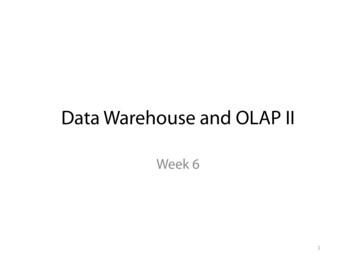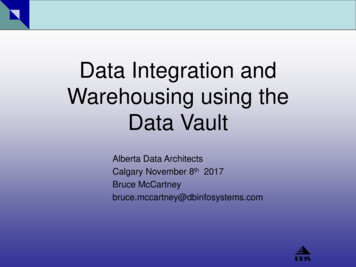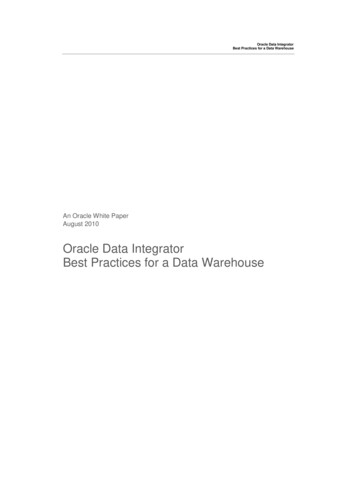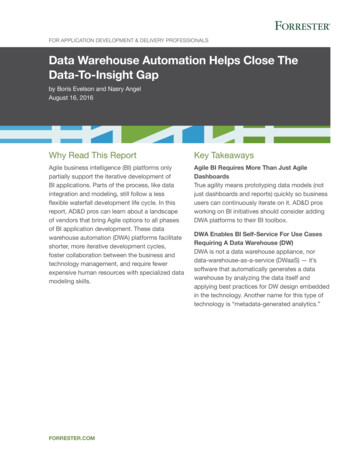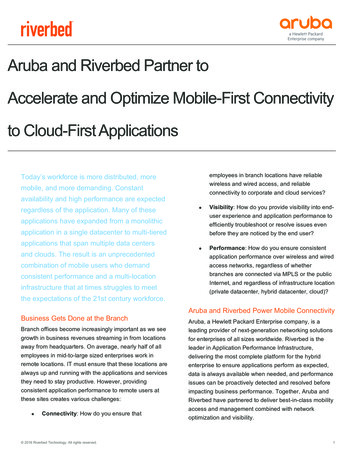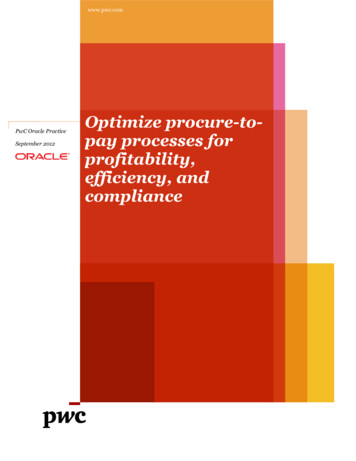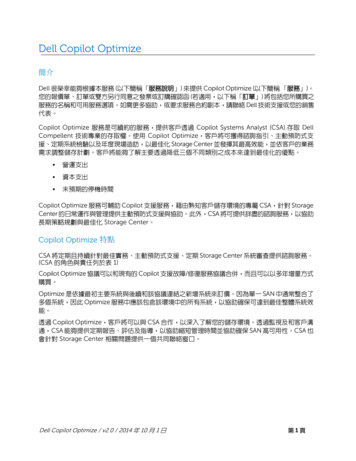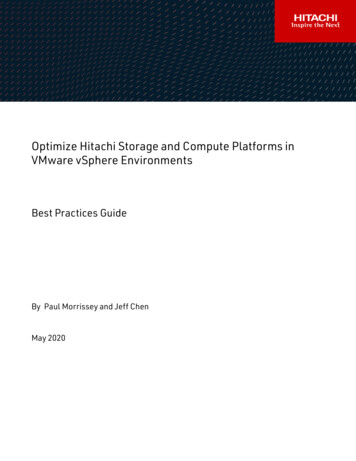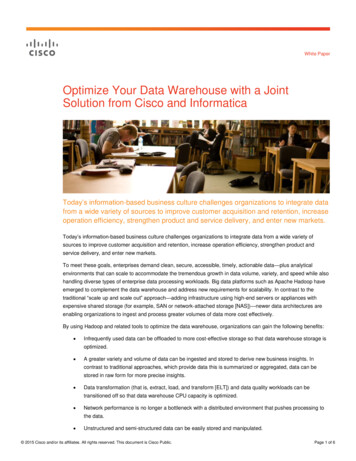
Transcription
White PaperOptimize Your Data Warehouse with a JointSolution from Cisco and InformaticaToday’s information-based business culture challenges organizations to integrate datafrom a wide variety of sources to improve customer acquisition and retention, increaseoperation efficiency, strengthen product and service delivery, and enter new markets.Today’s information-based business culture challenges organizations to integrate data from a wide variety ofsources to improve customer acquisition and retention, increase operation efficiency, strengthen product andservice delivery, and enter new markets.To meet these goals, enterprises demand clean, secure, accessible, timely, actionable data—plus analyticalenvironments that can scale to accommodate the tremendous growth in data volume, variety, and speed while alsohandling diverse types of enterprise data processing workloads. Big data platforms such as Apache Hadoop haveemerged to complement the data warehouse and address new requirements for scalability. In contrast to thetraditional “scale up and scale out” approach—adding infrastructure using high-end servers or appliances withexpensive shared storage (for example, SAN or network-attached storage [NAS])—newer data architectures areenabling organizations to ingest and process greater volumes of data more cost effectively.By using Hadoop and related tools to optimize the data warehouse, organizations can gain the following benefits: Infrequently used data can be offloaded to more cost-effective storage so that data warehouse storage isoptimized. A greater variety and volume of data can be ingested and stored to derive new business insights. Incontrast to traditional approaches, which provide data this is summarized or aggregated, data can bestored in raw form for more precise insights. Data transformation (that is, extract, load, and transform [ELT]) and data quality workloads can betransitioned off so that data warehouse CPU capacity is optimized. Network performance is no longer a bottleneck with a distributed environment that pushes processing tothe data. Unstructured and semi-structured data can be easily stored and manipulated. 2015 Cisco and/or its affiliates. All rights reserved. This document is Cisco Public.Page 1 of 6
Solution OverviewTo help customers quickly capture the value of Hadoop, Cisco and Informatica are offering a joint data warehouseoptimization solution (Figure 1). This solution provides a single platform for offloading processing and storage fromdata warehouses to Hadoop. It consists of the Cisco Unified Computing System (Cisco UCS ), Informatica BigData Edition, a Hadoop distribution of the customer’s choice, and Cisco Data Virtualization. The joint offeringprovides the services to help customers analyze their current data warehouse utilization and assess opportunitiesfor offloading. Where potential savings are identified, Informatica Big Data Edition enables customers to run datatransformation and data quality processes using a simple visual development environment on Hadoop clustersinstalled on Cisco UCS servers. The distributed data environments can be federated using Cisco DataVirtualization to provide business intelligence and analytics with a single point of access to all data.Figure 1.Data Warehouse Optimization ArchitectureProductsCisco UCS Intergrated Infrastucture for Big DataCisco UCS changes the way organizations do business through policy-based automation and standardization of ITprocesses. Cisco UCS combines industry-standard x86-architecture servers, networking, and enterprise-classmanagement into a single system. The system’s configuration is entirely programmable using unified, model-basedmanagement to simplify and accelerate deployment. A unified I/O infrastructure uses a high-bandwidth, lowlatency unified fabric to support networking, storage I/O, and management traffic. The system uses a wire-oncearchitecture with a self-aware, self-integrating, intelligent infrastructure that eliminates the time-consuming, manual,error-prone assembly of components into systems.The Cisco UCS Intergrated Infrastucture for Big Data, the third geneartion of Cisco Common PlatformArchitecture (CPA) for Big Data, is a highly scalable architecture designed to meet a variety of scale-outapplication demands. The solution has been widely adopted for agriculture, education, finance,healthcare, service provider, entertainment, insurance, and public-sector environments. The Cisco UCS 2015 Cisco and/or its affiliates. All rights reserved. This document is Cisco Public.Page 2 of 6
Integrated Infrastructure solution improves performance and capacity. It also offers additional completesolutions with industry-leading partnerships.With complete, easy-to-order packages that include compute, storage, connectivity, and unifiedmanagement features, Cisco UCS Integrated Infrastructure for Big Data accelerates deployment,delivers predictable performance, and reduces total cost of ownership (TCO).Informatica Big Data EditionInformatica Big Data Edition and Hadoop enable organizations to integrate and prepare greater volume and varietyof data faster and more economically. Informatica simplifies the ingestion of all types of data, including customertransactions and interactions, mainframe data, server logs, and sensor data, in batches and in real time, usinghundreds of prebuilt connectors. Informatica supports high-speed data ingestion to Hadoop using nativeconnectivity to applications, databases, machines, social media, and prebuilt parsers for industry formats includingFIX, SWIFT, HL7, HIPAA, EDI, and ASN.1. Informatica also supports multiple styles of data ingestion, includingbatch processing, log-based replication, change-data capture, and real-time streaming.Informatica developers can then profile, parse, integrate, cleanse, and refine the data up to five times faster using asimple visual development environment, prebuilt transformations, and reusable business rules. Because datapipelines are optimized and abstracted from underlying processing technology, developers can adopt newtechnology innovations without the risk of needing to redo work as Hadoop continues to change and evolve. Withmore than 100,000 developers skilled in Informatica technology, organizations can use existing skills andaccelerate project staffing.Visual development environment: Most Hadoop development today is performed manually in a manner similar tothe way that ETL code was developed a decade ago, before ETL tools such as Informatica PowerCenter werecreated. Graphical codeless development has already proven to reduce development time by as much as 500percent while identifying data errors not caught by manual Hadoop coding. Universal data access: Organizations use Hadoop to store and process a variety of diverse data sourcesand often face challenges in combining and processing all relevant data from their traditional data sourcesalong with new types of data. Informatica Big Data Edition helps organizations easily and reliabilityperform preprocessing and postprocessing of data into and out of Hadoop. High-speed data ingestion: Access, load, transform, and extract big data to and from source and targetsystems or directly into Hadoop or your data warehouse using native connectivity to applications,databases, machines, social media, and prebuilt parsers for industry-standard formats. Collect log filesand machine and sensor data in real time and reliably stream data at scale directly into Hadoop. Comprehensive data transformation: Hadoop excels at storing diverse data, but the capability to derivemeaning and make sense of it across all relevant data types is a major challenge. Informatica Big DataEdition provides an extensive library of prebuilt transformation capabilities on Hadoop for data integration,data parsing, and data quality. Integrate, cleanse, and prepare all types of structured and unstructureddata natively in Hadoop. Holistic data governance: Profile data on Hadoop to understand the data, identify data quality issues, andcollaborate on data pipelines. Automate the discovery of data domains and relationships on Hadoop suchas sensitive data that needs to be protected. Help ensure complete transparency of data pipelines with 2015 Cisco and/or its affiliates. All rights reserved. This document is Cisco Public.Page 3 of 6
end-to-end data lineage of all data movement from source data, through Hadoop, and to targetapplications.Cisco Data VirtualizationCisco Data Virtualization federates disparate data, abstracts and simplifies complex data, and delivers the resultsas data services or relational views (that is, logical business views) to consuming applications such as businessintelligence and analytics tools and other information dashboards. With advanced query optimization technology, itdelivers extremely high performance.After the selected warehouse data has been offloaded to Hadoop, Cisco Data Virtualization is used to federateboth data sources and offer a single view of the data. Analytics and business intelligence reports are enrichedbecause they now have access to more data from the warehouse as well as the from Hadoop big data store.The main features of Cisco Data Virtualization include: Data access: Connect and expose data from diverse sources. Data federation: Process and optimize queries across the data warehouse, Hadoop big data stores, andmore. Optimized algorithms accelerate queries across disparate data sources. Data delivery: Deliver data to diverse consuming applications through data services, including analyticsand business intelligence tools.ServicesAs part of the solution, Cisco and Informatica offer onsite professional services to help you complete the projectsuccessfully. We follow an implementation methodology with documented and proven tasks to get the job doneright and on time. The services are summarized here: Assess: Before you deploy any products, our team will examine your data warehouse and ITenvironments. We develop a picture of your data and transformation workload. Then we create a plan ofaction that describes what needs to be offloaded and the best way to do so. Virtualize: Deploy a data abstraction layer above your data warehouse and big data cluster. This layerhides any complexity in the physical data layer. Data and ETL migration can take place without disruptingthe business intelligence and analytics applications that consume the data. Migrate: Map data and ELT and ETL workloads to be transitioned. Determine the data movementapproach and migrate identified data and workloads from the warehouse to the big data target. Operate: We help you establish an operating plan to enable you to run the solution after it is live. Standardoperating procedures are documented for administrators to reference as needed.In addition, we offer services to plan and design the physical infrastructure, as well as the software configurationsto help you deploy a predictable and scalable environment. We can work with you to: Provision a network to handle the multiple streams of data traffic between the data warehouse, theInformatica server. and the Hadoop nodes Deploy a network infrastructure that can handle the consumption by business intelligence and analyticsapplications that federate data warehouse and Hadoop data through the Cisco Data Virtualization layer 2015 Cisco and/or its affiliates. All rights reserved. This document is Cisco Public.Page 4 of 6
Absorb large bursts of I/O traffic that occur during initial data load as well as internodal traffic duringHadoop processingSolution BenefitsBusiness BenefitsThe Informatica and Cisco Data Warehouse Optimization solution delivers a high impact on net income, with asubstantial return on investment. Business benefits include: Cost control: Offload data and computation processing to get more from your technology investments. Enhanced analytics: Access not just current and recent history but extended historical data that typically isarchived and not accessible. Competitive advantage: Use your company’s massive data assets with effective analytics to increaseproductivity and address business change. Reduced risk: Use proven software, networking, and computing infrastructure to adopt big data andlogical data warehousing.Technical BenefitsThe offering also provides a number of technical benefits that are unique to the solution’s combination of best-inclass Cisco and Informatica products and services. Technical benefits include: Linear scalability: The platform is designed to scale with simplicity as your data volume increases. It cangrow to up to 160 Hadoop nodes without the need to add any new switching components or redesign thesystem’s connectivity in any way. Furthermore, it can scale up to 10,000 servers, all managed within asingle management domain with Cisco UCS Central Software. Simplified data migration: Simplify the processing of data transformation and data quality jobs withInformatica Big Data Edition. Using an intuitive visual development environment with hundreds of prebuiltconnectors and transformations, developers are up to five times more productive than when they usemanual coding. Query optimization: Cisco Data Virtualization contains a comprehensive set of techniques and algorithmsfor federating disparate data. This intellectual property is the result of hundreds of person-years ofresearch and development. High performance: Cisco UCS delivers the adaptive performance needed to handle the diverse workloadsfor both ETL offload and regular Hadoop jobs. The solution’s low-latency, lossless 10-Gbps unified fabricis fully redundant and, through its active-active configuration, delivers higher performance compared toother vendors’ solutions. It handles the peak I/O load from clients while maintaining a quick responsetime. Deployment and management simplicity: The Cisco UCS platform can host big data and enterpriseapplications in the same management and connectivity domains, further simplifying data centermanagement. Informatica Big Data Edition uses the full power of the Hadoop framework, helping ensurethat all data pipelines built are production ready for high performance, scalability, availability, andmaintainability. 2015 Cisco and/or its affiliates. All rights reserved. This document is Cisco Public.Page 5 of 6
ConclusionCisco UCS and Informatica, along with Hadoop vendors, bring the power of big data to radically transform theexisting enterprise data warehouse landscape with improved response time as well as lower total cost of ownership(TCO) to meet the challenges of growing data volumes and new types of data. This approach also reducesoperating costs with improved productivity and simplified deployment of Informatica Big Data Edition along withCisco UCS CPA for Big Data and Cisco Data Virtualization, offering a solution that can be implemented rapidly andcustomized for either best performance or high capacity.For More InformationFor more information about Cisco UCS big data solutions, please visit http://www.cisco.com/go/bigdata.For more information about Cisco UCS Integrated Infrastructure for Big Data, please visithttp://blogs.cisco.com/datacenter/cpav3.For more information about Cisco Data Virtualization, please visit http://www.cisco.com/go/datavirtualization.For more information about Cisco Validated Designs for big data, please tml.For more information about Informatica Big Data Edition, please visit ormatica-big-data-editionPrinted in USA 2015 Cisco and/or its affiliates. All rights reserved. This document is Cisco Public.CXX-XXXXXX-XX10/11Page 6 of 6
Informatica Big Data Edition and Hadoop enable organizations to integrate and prepare greater volume and variety . Cisco Data Virtualization federates disparate data, abstracts and simplifies complex data, and delivers the results as data services or relational views (that is, logical busin
